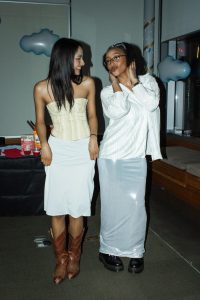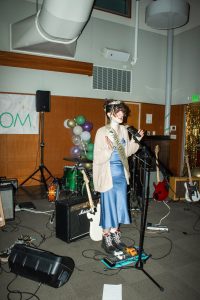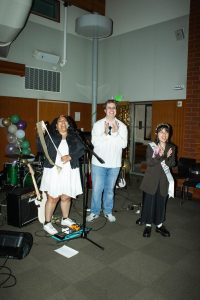
“Queer Prom” was a night of theatricality. The emancipatory utopia, housed in the alumni building in the Stuart Rolfe Room, May 3, provided an atmosphere of rich, cozy celebration. The night had poured in crowds of jeweled costumes. In its intimate space, the spirit of the room was playful. A lovely charade of kicking stilettos and angsty sounds. The angels were dancing.
Reign Riley, a third-year double major in film and media studies and sociology, disciplines his craft through a lens of societal reflection with his band “Fluttering,” an elaborate reinvention of alternative rock.
“Celebrating queerness is super important, especially how it relates to art and how the art scene is always tied to progressivism. Keeping that aspect of art alive, not only making sure that the art we’re playing is progressive, but that it also has some kind of progressive message too,” Riley said.
In the absence of critique, the bodies that dove themselves into the space that night grew feverish. As Reign’s student band, Fluttering picked up their kits and screamed their song, the people jumped and jumped.
Challenging heteronormative structures on campus, in the promotion of LGBTQ+ rights and experiences, fosters a sense of belonging. The prom grew ever intimate, gifted to queer identities.
AshLee Day, assistant director at MOSAIC, talked of the resurgence of queer sanctuaries on campus and the genesis of the event.
“The MOSAIC Center hosted the event once before and it was suggested by students, but that year was 2019 and after COVID, we had to start from scratch,” Day said.
Reestablishing events that celebrate queer culture at Seattle University necessitated a collaborative effort for the creation of an inclusive community that celebrates diversity. The arduous shove for events the Pride Link had cultivated underscores the ongoing commitments to advocate for LGBTQ+ rights, visibility, and resources within the university collective.
“This year, we went from one person on staff to four students working 10 to 15 hours a week. That has shifted and grown what’s available, but the first piece of the goal is community building and the resources for support,” Day said.

There are six Links spread throughout campus aimed to support student populations. These are spaces welcoming to various identities of student life.
“This space has been here and it’s been for LGBTQ+ students for a while. But, previously, it was just a room, there were pride flags, and nothing was happening. It really wasn’t until last year when I hired Sam [Grande, the event’s coordinator] that we started hosting multiple programs and we’re hoping this event can be a part of a larger consistent calendar of what we have to offer” Day said.
The efforts being made by MOSAIC, launching venues for queer bodies, surpasses the initiatives the university has done historically. In an attempt to forego institutional homogeneity, MOSAIC seeks to pioneer inclusive channels that recognize the liveliness of queer experiences, fostering an environment where individuals feel seen, heard and valued.
Elaborating on the safe haven for diversity and acceptance, Alex Takemoto, a third-year interdisciplinary liberal studies major, articulates the Pride Link at MOSAIC as a refuge worth investment. The space beacons as more than a harbor of inclusivity, but as a manifestation of change.
“This is a place where if someone needs to vent, or if someone needs to sit or take a nap, the door’s always open. We don’t have all of the resources that the other [links] do, but we’ve managed to make a welcoming spot with what we have,” Takemoto said.
They looked around the room and pointed out the pieces that had bared the space. At the beginning of the year, “We didn’t have a couch, we didn’t even have that whiteboard,” Takemoto said.
The room had been underutilized and unoccupied before the current staff took it in. Now, the Pride Link sits in STCN 390 with an abundance of color and trinkets collected by the staff.
“The door is always open. I’ve gotten a lot of people coming through here just to say hi, and then those turn into three hour long conversations. It’s a safe haven, and it doesn’t matter how much someone knows about you, there’s just a general sense of safety and belonging here,” Takemoto said.

Sam Grande, a fourth-year film and media studies major and the event’s coordinator, had requested that “Queer Prom” take place this year. Its one-time legacy of representation, from 2019, inspired Grande’s advocation. The event’s theme played off “Renaissance,” meant to avenge a history where queerness had been marginalized. Or, rather, intercept the theme with the modernity of Beyoncé’s disco X house music flair that acclaimed LGBTQ+ identity.
Hannah Cox, a first-year social work major, collaborated on the event. She talked about her excitement for the prom, expressing her anticipation for what the MOSAIC Center’s team had created.
“This event is something we needed. A dance, a celebration of queerness, a celebration of life,” Cox said.
For many, this was their first prom, a space catered to the celebration of queer identity without fear of judgment. Rainbow banners dressed the walls, as glittering streamers waved at the entrances. They huddled in the room’s main space, at the feet of the student band, exchanging laughters and small conversation. Tonight, they would create memories, surrounded by embrace.
Ren Meyers, a second-year film and media studies major, soaked in the event’s atmosphere belonging to them.
“I didn’t go to my [high school’s] prom for a multitude of reasons. COVID was one of them and it was also scary to go in general. This event is a lot more approachable, because I know everyone here, I knew that everyone was going to be similar to me, and in high school, it wasn’t that way,” Meyers said.
As Meyers spoke, a kaleidoscope of identities, appearing in angel wings and clownery, clustered the building, each outfit a testament to the blend of self-expression. Fashion, here, highlighted the ensemble of bold and striking personalities, a way to express queerness without whispering a word.

Kyra Hart, a second-year psychology major, and Tristynn Cadez, an incoming Seattle U student, walked in while giggling with each other. Their attire had been textured in lace and leather, their makeup pale and gothic. Hart laughed and explained their ensemble.
“It’s definitely a little jester-y-esque,” Hart said.
In this space that upset normality, the authenticity in fashion and culture felt free. The lure to behave and dress in a way that aligns with their identity festered all around the building, where diversity was not only invited but encouraged. Cadez emphasized the importance of events like the “Queer Prom,” in hopes that this night encouraged the involvement of queer bodies into the collective.
“We gotta have a place where we can feel safe! A place to feel loved, and normal. I remember going to prom in high school and feeling weird. We need to feel accepted with whatever we do and without judgment,” Cadez said.
Grande elaborated on their process pioneering the event, noting that students had wanted smaller events highlighting queerness throughout the quarters as opposed to low funded festivities just once a year.
“There’s nothing really established for queer students throughout the school year. We have the Lavender Celebration, but that’s exclusive to our graduating queer students already leaving the school. It’s important to celebrate them, yes, but they should be celebrated throughout their four years. I had advocated for ‘Queer Prom’ as an event opened for anyone wanting to come but especially for queer identities,” Grande said.

In advocating for institutional recognition of queer bodies, Day reflects on the collaborative efforts that had led to the prom.
“SU definitely has room for growth in terms of creating spaces and availability for queer students. You have to convince people that something is valuable before they’ll invest in it. These past couple of years, and working with this team of students, in particular, has led to convincing [the university] that it’s worth their investment,” Day said.
There’s a lot that needs to be done in labeling our campus a sanctuary for all. The hypocrisy of inclusivity festering our campus contradicts the efforts the university has put into creating spaces and resources for queer identities. The MOSAIC Center will continue their push in advocating havens at Seattle U and progressing the integration of queer events into the campus itinerary.














